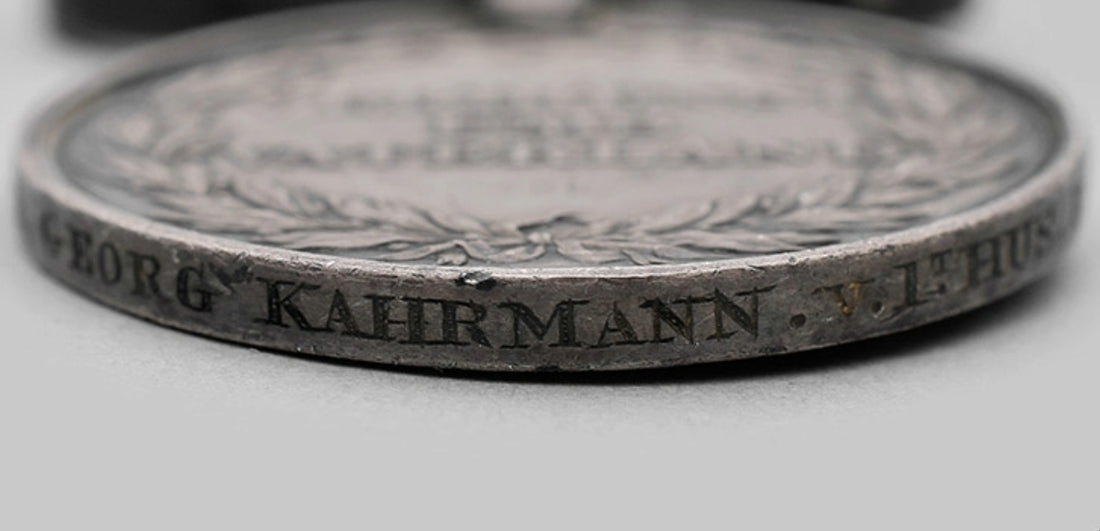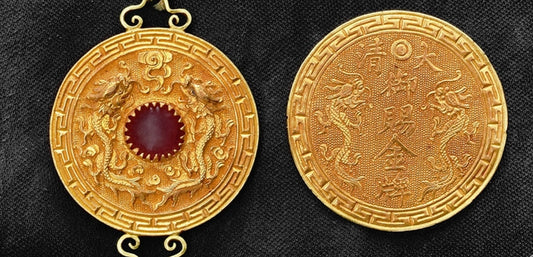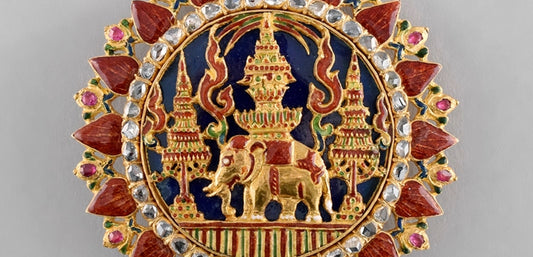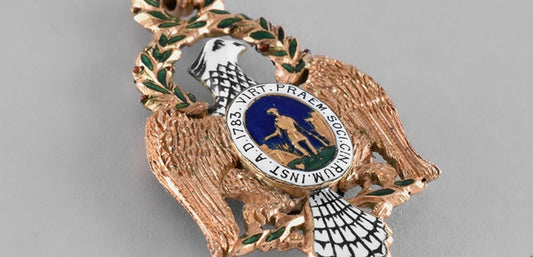eMedals was pleased to present to market for the first time, the Napoleonic Wars medal group of Wachtmeister George Kahrmann, 1st Hussars, King's German Legion. Offered by order of a direct descendant, the proceeds generated from the sale were allocated for the writing of articles aimed at enhancing the Kahrmann family history in their home region of Argentina. Having been proudly displayed in a Victorian era showcase at their family estate for 5 generations, eMedals was humbled by the opportunity and $15,000 USD sale of this unique Napoleonic group in 2020.
Military General Service 1793-1814, 7 clasps: PYRENEES, VITTORIA, SALAMANCA, CIUDAD RODERIGO, FUENTES D’ONOR, BUSACO, TALAVERA, rim officially impressed GEORGE KAHRMAN, SERJT 1ST HUSSARS, K.G.L, measures 36.10mm (w) x 42.39mm (h – inclusive of integral suspension ball), weighs 42.5 grams, worn on incorrect period ribbon, very minor contact wears, lovely patina, in very fine condition.
Waterloo Medal 1815, officially impressed SERJ. MAJOR GEO. KAHRMANN 1ST REG. HUSSARS, K.G.L, measures 35.90mm (w) x 41.50mm (h – including integral suspension ball), weighs 35.3 grams, worn on a Hanoverian suspension bar with an incorrect period ribbon, light wear and edge bruising, in overall very fine condition.
Hanoverian Medal for Volunteers of the K.G.L. 1814,in bronze, measures 34.38mm (w) x 39.90mm (h – includes integral suspension ring), weighs 23.8 grams, with a ring suspension, attached to an incorrect period ribbon, edge bruise to 4 o’clock reverse, rim, otherwise in near extremely fine condition.
“Attested by sir F. von Arentschildt, and baron Krauchenberg. Sergeant George Kahrmann, 1st hussars. In the battle of Salamanca the 1st hussars were ordered to attack the left wing of the enemy’s cavalry. In order to reach this point, it was necessary to pass the defile, at the end of which they enemy awaited them in superior force, and pressed upon the hussars with such impetuosity, that their retreat would have been endangered, had not Kahrmann and a few men who followed him, thrown themselves into the midst of the French column, and thus opened a free passage for the regiment. On the 12th of June 1813, being in command of a picquet consisting of six hussars, he fell upon the French rear guard and captured a gun.”
Serjeant Kahrmann was also noted in additional citations:
“On the march of the allied army to Vittoria, June 18, 1813 captain Aly’s squadron formed the advanced guard, in front of the light divisions near St. Milan. Skirmishes were sent out under serjeant Kahrmann, and after they had passed a defile, perceived the third French hussars in their front. Three hussars of this regiment rode towards the right flank of the German skirmishers, and the serjeant called out: “Who will go and attack the fellows?”, upon which, Bleidong immediately rushed forward.
In the month of June 1813, a short time after the battle of Vittoria, [Hussar] Graue and serjeant Kahrmann were on patrole, which was hard pressed and pursued by the enemy, and obliged to cross a wide ditch, into which one of the men fell. Five of the enemy’s chasseurs immediately surrounded him, and he would have inevitably have been lost, had not Graue alone, re-crossed the ditch, - cut one of the chasseurs from his horse, - mortally wounded another, and put the rest to flight.”
The Battle of Salamanca, also known as the Battle of Arapiles, occurred in late July of 1812 in which the Duke of Wellington leading the Anglo-Portuguese army defeated Marshal Auguste Marmot’s French forces during the Peninsular War. Skirmishes broke out around two flat-topped hills called the Greater and Lesser Arapiles. The British forces occupied the Lesser, the French had the Greater. Just prior to the great outbreak of battle, Serjeant George Kahrmann was recognized for breaking through the ravine of Zurguen and clearing a route for all to follow, allowing for the first contact to be made. At the end of this specific engagement, six men were killed, and twenty-six were wounded. An additional 36 horse casualties were endured.





